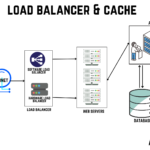Title: Understanding SolrCloud Architecture in Virtual Machines and Application Integration
Introduction
In today’s data-driven world, efficient search capabilities are essential for any application. SolrCloud, with its distributed architecture, ensures high availability, fault tolerance, and scalability. This blog explains how to set up SolrCloud on virtual machines and demonstrates how to integrate it with Java or Python applications using SolrJ API for JSON responses.

Architecture Overview
The architecture involves the following components:
- User Interface: The entry point where users interact with the system.
- Security Layer: Managed via an F5 load balancer, ensuring secure communication.
- Application Server: A Java or Python application deployed here communicates with SolrCloud.
- Database Server: Stores and retrieves data needed by the application.
- SolrCloud Cluster: Managed with Apache Zookeeper for coordination. Version 9.0 is used in this setup.
- Monitoring Tool: The ELK stack (Elasticsearch, Logstash, Kibana) monitors SolrCloud.
Flow:
- The user sends a query through the UI.
- The query passes through the security layer and application server.
- The application server forwards the query to SolrCloud.
- SolrCloud processes the request and returns the results in JSON format.
Setting Up SolrCloud
- Install Apache Solr and Zookeeper:
- Download and install Apache Solr on your virtual machines.
- Set up a Zookeeper ensemble for coordination.
- Configure SolrCloud:
- Define the number of shards and replicas in the
solr.xmlfile. - Use the Solr Admin UI to create and manage collections.
- Define the number of shards and replicas in the
- Deploy on Virtual Machines:
- Assign unique IPs to your VMs.
- Configure firewalls and ensure network connectivity between nodes.
Application Integration
Here’s how Java and Python applications can query SolrCloud using the SolrJ API.
Java Implementation:
import org.apache.solr.client.solrj.SolrClient;
import org.apache.solr.client.solrj.impl.HttpSolrClient;
import org.apache.solr.client.solrj.response.QueryResponse;
import org.apache.solr.common.params.SolrParams;
import org.apache.solr.common.params.ModifiableSolrParams;
public class SolrIntegration {
public static void main(String[] args) {
String solrUrl = “http://:8983/solr/”;
SolrClient solrClient = new HttpSolrClient.Builder(solrUrl).build();
ModifiableSolrParams params = new ModifiableSolrParams();
params.set("q", "field:value");
params.set("wt", "json");
try {
QueryResponse response = solrClient.query(params);
System.out.println("Response: " + response.getResponse());
} catch (Exception e) {
e.printStackTrace();
}
}}
Python Implementation:
import requests
solr_url = “http://:8983/solr//select”
params = {
‘q’: ‘field:value’,
‘wt’: ‘json’
}
response = requests.get(solr_url, params=params)
if response.status_code == 200:
print(“Response:”, response.json())
else:
print(“Failed to query Solr:”, response.status_code)
Conclusion
SolrCloud provides a robust solution for handling large-scale search requirements. By deploying it on virtual machines and integrating it with applications, you can ensure seamless search experiences for end users.






GIPHY App Key not set. Please check settings